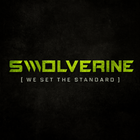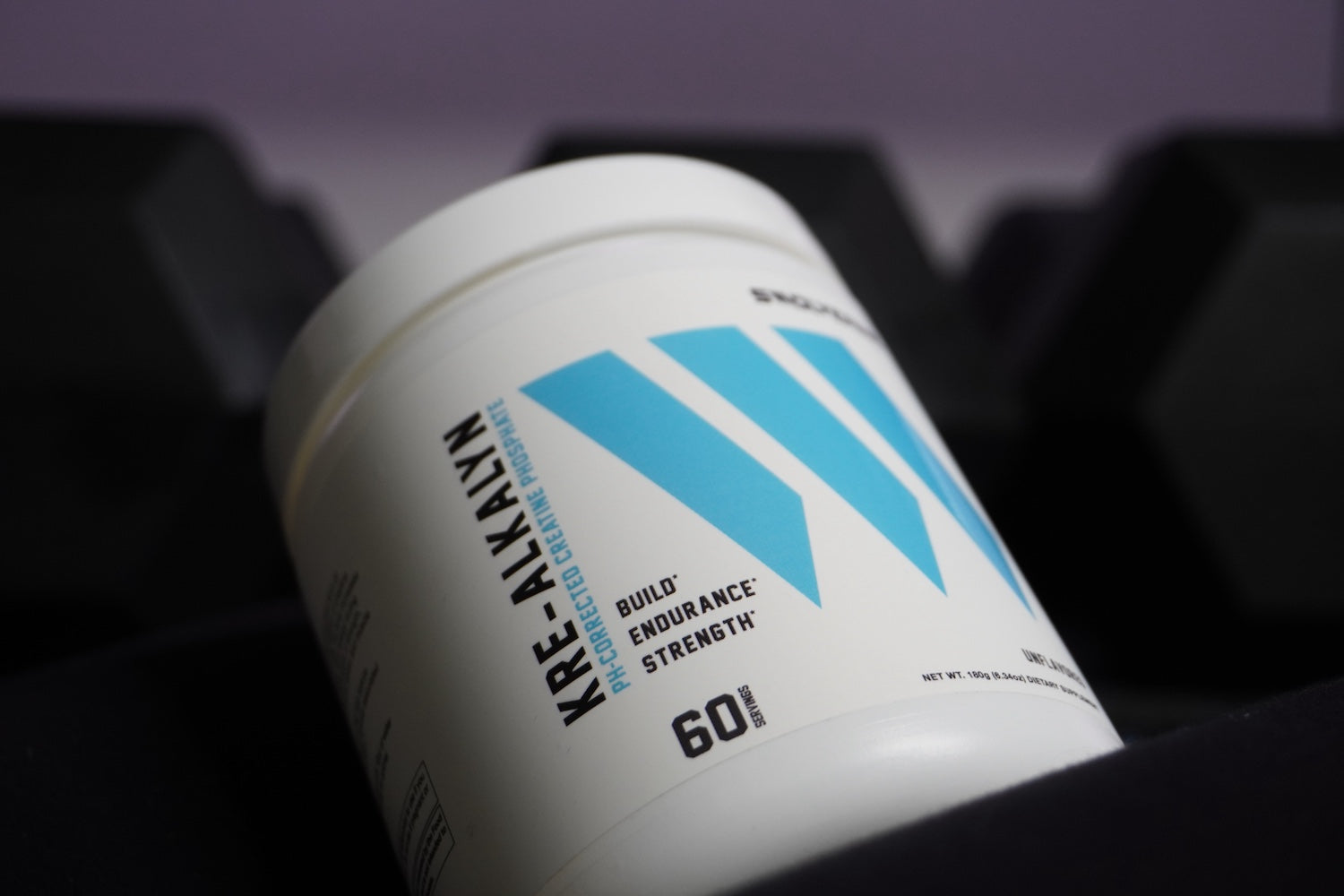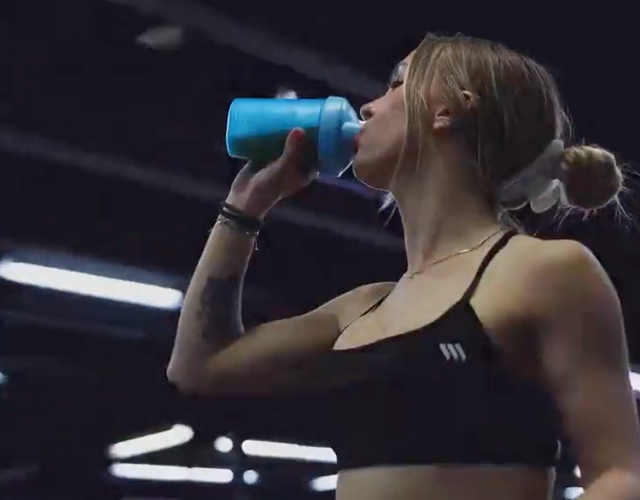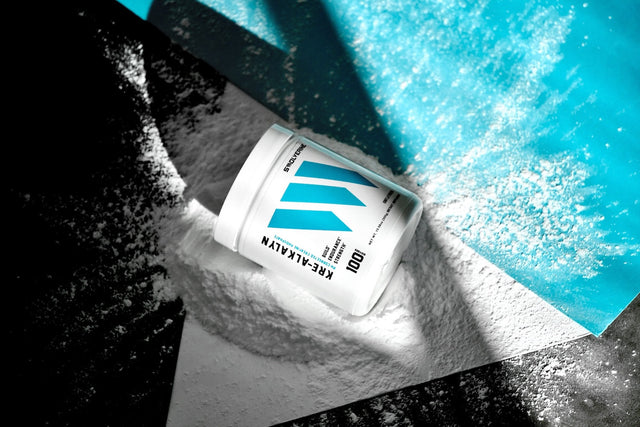Let’s be real — the “loading phase” for creatine can be annoying. You’re told to slam 20 grams a day for a week, split across multiple servings, all while dealing with possible bloating, water retention, or digestive discomfort. But what if there was a better way?
Turns out, you can get all the benefits of creatine — muscle strength, improved recovery, and performance gains — without doing a loading phase at all.
In this article, we’ll break down exactly what the creatine loading phase is, which types of creatine don’t require it, and how to supplement smarter for your goals. Whether you’re a beginner or seasoned lifter, we’ll show you how to get stronger without the bloat — and why Swolverine’s Kre-Alkalyn® Creatine might be the most effective, gut-friendly choice out there.
What Is Creatine and How Does It Work?
Creatine is a naturally occurring compound found in small amounts in foods like red meat and synthesized in the body from amino acids. It’s stored mostly in your muscles as phosphocreatine, which helps regenerate ATP — your body’s primary energy currency during high-intensity, short-duration efforts like sprinting or weightlifting.
Supplementing with creatine increases intramuscular phosphocreatine stores, allowing for:
-
Greater strength and power output
-
Improved muscular endurance
-
Faster recovery between sets
-
Enhanced lean muscle mass gains
“Creatine supplementation increases skeletal muscle total creatine content by 10–40% depending on the individual’s baseline levels,”
Kreider, Journal of the International Society of Sports Nutrition
It’s one of the most researched and effective sports supplements available — but how you take it, and what form you take, makes a huge difference in how well your body absorbs it.
The Loading Phase: What It Is and Why It's Used
The traditional approach to creatine supplementation includes a loading phase, where users take 20 grams per day (typically split into 4 doses) for 5–7 days, followed by a maintenance phase of 3–5 grams daily. The idea is to saturate muscle creatine stores quickly, leading to faster performance benefits.
However, this method isn’t always necessary — and for many athletes, it causes more issues than benefits.
Common drawbacks of the loading phase:
-
Gastrointestinal distress (cramps, bloating)
-
Temporary water retention
-
Inconsistent adherence (remembering 4 doses per day is annoying)
-
No significant long-term advantage over daily low-dose strategies
“Although the loading phase results in quicker saturation, taking 3–5g daily will eventually produce the same benefits after 3–4 weeks — without the side effects,”
Jagim, International Journal of Sport Nutrition and Exercise Metabolism
That’s why many lifters opt for creatine forms that skip the loading phase entirely, offering better bioavailability and fewer side effects from day one.
Creatine Types That Don’t Require a Loading Phase
If you're looking to avoid the hassle (and bloating) of a loading phase, you're in luck — several advanced forms of creatine are designed to deliver benefits without front-loading high doses. These versions are often more stable in the body and better absorbed.
✅ 1. Creatine Hydrochloride (HCL)
Creatine HCL is bound with hydrochloric acid, increasing its solubility in water and its absorption rate in muscle tissue. Because it’s more bioavailable, lower doses are effective, and there’s no need for loading.
“Creatine HCL’s increased solubility may reduce gastrointestinal issues compared to creatine monohydrate,”
Antonio, Journal of the International Society of Sports Nutrition
✅ 2. Kre-Alkalyn®
Kre-Alkalyn is a patented, pH-buffered form of creatine that resists breakdown in the stomach and gets delivered directly to muscle tissue. It requires no loading, no cycling, and no water retention — making it ideal for lifters who want strength without the fluff.
“Kre-Alkalyn supplementation in resistance-trained individuals increased strength gains without water retention or side effects,”
Stout, Journal of Strength and Conditioning Research
Swolverine’s Kre-Alkalyn Creatine is dosed at just 1.5g per serving — with no need to load — and provides long-term strength and performance gains without the bulk.
✅ 3. Micronized Creatine Monohydrate (Low-Dose)
Micronized monohydrate is simply creatine broken into smaller particles for better solubility. While it still technically can use a loading phase, many users take 3–5g daily without loading and still see results in 3–4 weeks, with improved digestion.
Best Creatine Options Without Loading
If you want strength, performance, and lean muscle gains without the discomfort of loading or bloating, here are the top creatine supplements to consider:
Kre-Alkalyn® by Swolverine
-
Type: pH-buffered creatine (no loading required)
-
Dose: 1.5g daily
-
Key Benefits:
-
Faster ATP regeneration
-
No water retention or GI issues
-
Ultra-stable and easily absorbed
-
-
Best For: Lifters focused on clean strength gains, body composition, or avoiding stomach upset.
“Buffered creatine forms like Kre-Alkalyn allow for better muscle uptake without requiring high initial doses,”
Kreider, Journal of the International Society of Sports Nutrition
Creatine Hydrochloride (HCL)
-
Type: Highly soluble creatine salt
-
Dose: 750mg–2g daily depending on weight
-
Pros: Easy on the gut, no bloating, rapid uptake
-
Cons: Not as widely studied as monohydrate; slightly more expensive
Micronized Creatine Monohydrate (Low Dose Daily)
-
Type: Traditional creatine in refined form
-
Dose: 3–5g daily
-
Best For: Budget-conscious lifters who don’t mind waiting ~4 weeks for saturation
-
Tip: Combine with a carb or sodium-rich drink to improve uptake
Kre-Alkalyn vs Creatine Monohydrate: Key Differences
Creatine monohydrate is the most researched form of creatine — but it's also associated with water retention, bloating, and the need for a loading phase. Kre-Alkalyn is a pH-buffered form of creatine designed to bypass these drawbacks, offering enhanced stability, absorption, and usability.
Here’s a breakdown:
| Feature | Creatine Monohydrate | Kre-Alkalyn |
|---|---|---|
| Requires Loading Phase | ✅ Yes | ❌ No |
| Causes Bloating | ✅ Common | ❌ Rare |
| Dosing | ➡️ 20g/day loading, 5g/day maintenance | ➡️ 1.5–3g/day |
| Absorption Rate | Moderate | ✅ High |
| Stability in Liquid | ❌ Degrades over time | ✅ Stable |
| Gut Distress | ✅ Sometimes | ❌ Less Likely |
| Scientific Research | ✅ Extensive | ➡️ Growing |
| Cost | ✅ Affordable | ❌ Slightly More |
“Buffered creatine (Kre-Alkalyn) has demonstrated similar strength and performance outcomes as creatine monohydrate without the side effects of water retention,”
Stout et al., Journal of the International Society of Sports Nutrition
Benefits of Choosing a No-Loading Creatine
Skipping the loading phase doesn’t mean skipping results. In fact, using a no-load creatine like Kre-Alkalyn offers several advantages — especially for those concerned with digestion, water retention, or overall training comfort.
1. No Gastrointestinal Distress
Creatine loading (typically 20g/day for 5–7 days) often causes bloating, gas, and cramping. Buffered creatine avoids these issues altogether.
“High-dose creatine loading can lead to gastrointestinal complaints in some individuals,”
Jäger et al., Journal of the International Society of Sports Nutrition
2. No Water Retention or Puffy Look
Monohydrate tends to pull water into the muscle, which can increase weight or create a “softer” appearance — not ideal for those cutting or recompositioning.
3. More Convenient Dosing
With Kre-Alkalyn or creatine HCL, you can take 1.5–3g daily at any time — no saturation period or cycling needed. That means less hassle and better long-term compliance.
4. Leaner Gains Over Time
With less extracellular water retention and greater cellular uptake, buffered creatine may support lean muscle growth without excess weight fluctuations.
When to Use a Loading Phase (If Ever)
While no-loading creatine offers convenience and fewer side effects, there are still scenarios where a traditional loading phase might be appropriate—especially for athletes looking for rapid saturation and performance boosts within a short window.
When a Loading Phase Might Be Useful:
-
Time-sensitive goals
If you're peaking for a meet, shoot, or competition and want to maximize intracellular creatine levels fast, a loading protocol (20g/day for 5–7 days) can help saturate muscles in under a week. -
Beginners with low baseline creatine stores
If you’ve never used creatine before, your muscles may respond faster to a front-loaded approach—though it’s not essential.
“Creatine loading accelerates muscle saturation, but long-term benefits remain the same whether a loading phase is used or not.”
Buford et al., Journal of the International Society of Sports Nutrition
When You Can Skip It:
-
You’re in no rush and prefer a gradual approach
-
You’re prone to bloating or water retention
-
You’re already taking a more bioavailable form like Kre-Alkalyn or creatine HCL
-
You value simplicity and adherence over rapid results
Loading is optional — not required. The benefits of creatine are cumulative and consistent over time.
How To Take Creatine Without a Loading Phase
If you’re using a high-absorption form like Kre-Alkalyn Creatine, you can ditch the loading phase entirely—and still reap the full muscle, strength, and performance benefits.
Daily Dose
Take 1.5g to 3g per day, ideally around your training window. Unlike creatine monohydrate, Kre-Alkalyn doesn't require high doses or cycling.
“Buffered creatine requires lower doses to achieve comparable effects, with fewer gastrointestinal issues and less water retention,”
Stout et al., Journal of the International Society of Sports Nutrition
Timing
-
Before Training: Supports intramuscular ATP regeneration and may improve endurance.
-
After Training: May enhance cellular uptake when insulin sensitivity is higher (especially if paired with carbs or protein).
-
On Rest Days: Still take it—consistency matters more than timing.
With or Without Food?
Buffered creatine can be taken with or without food. However, taking it with a meal or post-workout shake (like Swolverine’s Clean Carbs) may enhance absorption through insulin-mediated pathways.
Supplement Stack Suggestions (No Loading Required)
To amplify the benefits of creatine — especially if you’re skipping the loading phase — consider pairing it with other supplements that support performance, endurance, and recovery. These additions can enhance creatine uptake and help build lean mass more efficiently.
→ 1. Beta-Alanine
Combining creatine with beta-alanine increases muscular endurance and improves high-intensity performance. This combo works synergistically to buffer lactic acid and sustain longer workouts.
“Co-supplementation of creatine and beta-alanine enhances strength and lean body mass better than creatine alone,”
Hoffman, Journal of Strength and Conditioning Research
→ 2. Citrulline Malate
Citrulline Malate enhances nitric oxide production, improving blood flow and nutrient delivery to muscles. Taking this before training can increase creatine transport and maximize muscle pump and performance.
“Citrulline Malate has been shown to improve exercise performance and reduce fatigue by increasing ATP production and oxygen availability,”
Bailey, Journal of Applied Physiology
→ 3. Krill Oil
Krill Oil provides essential omega-3 fatty acids that support recovery, reduce inflammation, and improve joint health — particularly beneficial when creatine is increasing training intensity and output.
“Omega-3 supplementation may enhance muscle recovery and reduce muscle soreness post-exercise,”
Jouris, Clinical Journal of Sports Medicine
→ 4. ZMT (Sleep + Testosterone Support)
ZMT by Swolverine combines magnesium, zinc, ashwagandha, GABA, L-theanine, L-tryptophan, and melatonin to promote deeper sleep, hormonal balance, and recovery — which are critical for creatine to do its job effectively.
“Deep sleep is when the majority of growth hormone is secreted, optimizing muscle repair and strength gains,”
Van Cauter, The Journal of Clinical Endocrinology & Metabolism
Nutrition Tips and Support from The Swole Kitchen
Creatine isn’t magic—it works best when paired with the right nutrition, training, and recovery strategy. At The Swole Kitchen, we specialize in building personalized coaching plans that help you maximize the benefits of performance supplements like creatine, without wasting time or guessing your macros.
🔹 Make Creatine Work Harder with These Tips:
-
Eat Enough Protein
Muscle repair and growth require a foundation of high-quality protein—typically 0.8–1.2g per pound of bodyweight.
Need help hitting your targets? We’ve got you. -
Support ATP Production with Clean Carbs
Swolverine’s Clean Carbs delivers carb sources like Carb10®, coconut sugar, and ribose that replenish glycogen, support creatine uptake, and optimize recovery. -
Stack With ZMT for Better Recovery
Sleep is when you grow. ZMT supports natural testosterone production and deep sleep with magnesium, zinc, ashwagandha, GABA, L-theanine, and melatonin. -
Stay Consistent
Creatine takes time to work. Whether you’re lifting, running, or rebuilding your metabolism, a personalized plan can keep you accountable—and that’s where 1:1 coaching with The Swole Kitchen delivers.
“The effects of creatine are amplified when paired with structured training and consistent nutrition.”
Kreider et al., Journal of the International Society of Sports Nutrition
Conclusion: Creatine Without Loading — Smarter Gains, No Bloat
You don’t need to suffer through a loading phase or deal with bloating to get results from creatine. Buffered forms like Kre-Alkalyn, creatine HCL, or even low-dose monohydrate allow for gradual muscle saturation without the discomfort. These options are ideal for athletes who value performance, consistency, and clean gains.
Pairing creatine with other effective supplements — like Citrulline Malate, Krill Oil, beta-alanine, and ZMT — can further support your strength, recovery, and body composition goals.
And if you’re not sure how to build a nutrition strategy around these supplements, our expert coaches at The Swole Kitchen can help you create a personalized plan that matches your goals, training volume, and recovery needs.
The bottom line: smart supplementation — not over-supplementation — is the key to sustainable performance. Creatine works. You just don’t need to load it.







